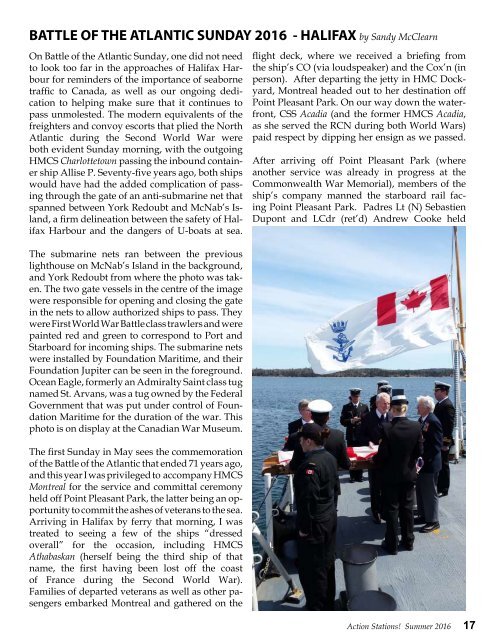ACTION STATIONS!
Action-Stations-Summer-email-and-web-issue-2016
Action-Stations-Summer-email-and-web-issue-2016
Create successful ePaper yourself
Turn your PDF publications into a flip-book with our unique Google optimized e-Paper software.
BATTLE OF THE ATLANTIC SUNDAY 2016 - HALIFAX by Sandy McClearn<br />
On Battle of the Atlantic Sunday, one did not need<br />
to look too far in the approaches of Halifax Harbour<br />
for reminders of the importance of seaborne<br />
traffic to Canada, as well as our ongoing dedication<br />
to helping make sure that it continues to<br />
pass unmolested. The modern equivalents of the<br />
freighters and convoy escorts that plied the North<br />
Atlantic during the Second World War were<br />
both evident Sunday morning, with the outgoing<br />
HMCS Charlottetown passing the inbound container<br />
ship Allise P. Seventy-five years ago, both ships<br />
would have had the added complication of passing<br />
through the gate of an anti-submarine net that<br />
spanned between York Redoubt and McNab’s Island,<br />
a firm delineation between the safety of Halifax<br />
Harbour and the dangers of U-boats at sea.<br />
The submarine nets ran between the previous<br />
lighthouse on McNab’s Island in the background,<br />
and York Redoubt from where the photo was taken.<br />
The two gate vessels in the centre of the image<br />
were responsible for opening and closing the gate<br />
in the nets to allow authorized ships to pass. They<br />
were First World War Battle class trawlers and were<br />
painted red and green to correspond to Port and<br />
Starboard for incoming ships. The submarine nets<br />
were installed by Foundation Maritime, and their<br />
Foundation Jupiter can be seen in the foreground.<br />
Ocean Eagle, formerly an Admiralty Saint class tug<br />
named St. Arvans, was a tug owned by the Federal<br />
Government that was put under control of Foundation<br />
Maritime for the duration of the war. This<br />
photo is on display at the Canadian War Museum.<br />
The first Sunday in May sees the commemoration<br />
of the Battle of the Atlantic that ended 71 years ago,<br />
and this year I was privileged to accompany HMCS<br />
Montreal for the service and committal ceremony<br />
held off Point Pleasant Park, the latter being an opportunity<br />
to commit the ashes of veterans to the sea.<br />
Arriving in Halifax by ferry that morning, I was<br />
treated to seeing a few of the ships “dressed<br />
overall” for the occasion, including HMCS<br />
Athabaskan (herself being the third ship of that<br />
name, the first having been lost off the coast<br />
of France during the Second World War).<br />
Families of departed veterans as well as other pasengers<br />
embarked Montreal and gathered on the<br />
flight deck, where we received a briefing from<br />
the ship’s CO (via loudspeaker) and the Cox’n (in<br />
person). After departing the jetty in HMC Dockyard,<br />
Montreal headed out to her destination off<br />
Point Pleasant Park. On our way down the waterfront,<br />
CSS Acadia (and the former HMCS Acadia,<br />
as she served the RCN during both World Wars)<br />
paid respect by dipping her ensign as we passed.<br />
After arriving off Point Pleasant Park (where<br />
another service was already in progress at the<br />
Commonwealth War Memorial), members of the<br />
ship’s company manned the starboard rail facing<br />
Point Pleasant Park. Padres Lt (N) Sebastien<br />
Dupont and LCdr (ret’d) Andrew Cooke held<br />
Action Stations! Summer 2016 17



